Rust Programming
Rust Basics
Writing and Running Your First Rust program
In this article, you'll learn how to write, compile, and run your very first Rust program. By the end of this lesson, you will understand the basic steps to create a Rust file, compile it using the Rust compiler, and execute the program from the terminal.
Creating the Rust File
Begin by creating a new Rust source file named main.rs. Remember that Rust source files must have the .rs extension. If you want to use multiple words for the filename, separate them with an underscore. For example, use hello_world.rs instead of hello world.rs.

Writing the Code
Open the main.rs file in your favorite text editor or IDE and add the following code. This simple program prints "Hello, world!" to the terminal:
fn main() {
println!("Hello, world!");
}
The code above defines the main function, which serves as the entry point for every Rust executable program. Inside the main function, the println! macro (identified by the exclamation mark) outputs the string "Hello, world!" to the console.
Note
In Rust, semicolons are used to differentiate between expressions and statements. Understanding when and how to use them is essential to prevent unexpected behavior.
Compiling and Running the Program
Once you have saved the file, open your terminal and navigate to the directory where your main.rs file is located. You will compile the program using the Rust compiler (rustc), which generates an executable file.
Step 1: Compile the Program
Run the following command in your terminal:
$ rustc main.rs
This command compiles your Rust code and creates an executable file named main.
Step 2: Execute the Program
To run your compiled Rust program, execute the following command:
$ ./main
If everything is set up correctly, you should see the following output in your terminal:
Hello, world!
Recap of Steps
In this lesson, you have:
- Created a
main.rsfile. - Defined a
mainfunction that prints a message using theprintln!macro. - Compiled the Rust program with
rustc. - Executed the generated executable file from your terminal.
Rust Project Management
While using rustc is sufficient for compiling simple programs, larger projects benefit from Cargo—a tool that manages dependencies, build configurations, and code sharing.
Quick Exercise: Creating a New Rust Project with Cargo
Before wrapping up, try creating a new project using Cargo. Write your "Hello, world!" program within the Cargo project structure and build it. To ensure your code remains consistent and properly formatted, use the rustfmt tool included with the Rust distribution. Simply run:
$ rustfmt main.rs
This command automatically formats your Rust code according to community style guidelines.

Watch Video
Watch video content